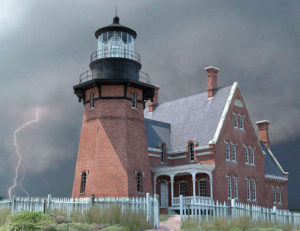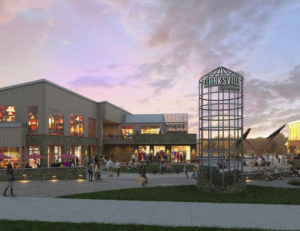Our niche industry used to simply encompass the mediums of pen and ink, watercolors, and pencil drawings. This was all done by hand. Some artists were also responsible for drawing floor plans and elevations. I can remember that when I went to interview for my first job in this field, I had to take tests on each medium. I completed a pen and ink test as well as watercolor. Of course I had a portfolio, but that wasn’t enough. The company considering hiring me needed to check for my speed, accuracy, and how well I could match the style that was expected – one style for the whole firm.
With these traditional mediums, executed solely by artist, renderings of buildings were done of interiors and exteriors. They would be used predominantly for marketing purposes, meaning they were used in all kinds of materials such as:
- Skrims – Large durable canvas-like material that can be used to advertise renderings of a structure not yet built. The skrim is then hung on the fence surrounding the construction zone so the public sees what the new construction will look like. The skrim also lists the construction company, developer, and architect and includes contact information for potential investors.
- Billboards – You’ve probably seen these around your town/city before. If there is a new condominium be built, for example, the billboard along the local road will advertise as much hopefully drawing in buyers before construction is complete.
- Pamphlets / Brochure – Nothing new here. In fact, I think we all expect to receive a pamphlet of construction that we may be interested in so that we can take it home. Floor plans and elevations were, and still are, often included in the pamphlet in order to provide a potential buyer with all of the information they need in one place.
- Power points – Developers and architects are familiar with including visualization in their presentations to other industry professionals or for the purposed of zoning.
- Any other printed marketing materials a company may use to nurture interest in the unbuilt architecture.
Then, in 2000 the industry created software packages like Sketchup and Revit for modeling and in the 90’s, 3DS Max and V-Ray to complete high end digital renderings in order to get the work done on computers. And just like that, photorealism was born. The notion that only artists could do this work now gave way to the idea that people who were really good at computers could do the same kind of work.
There is now a mix of those with computer and architectural backgrounds sitting side by side industry artists all completing the same kind of computer generated work. That said, today, while traditional renderings have become less popular and digital renderings have taken over the market, watercolors are still ordered and artists still exist who work solely in this medium.
As an artist, I remain convinced that my eye for detail benefits me and my employees exponentially as we strive to achieve true accuracy in all of our work.
Here are a couple pieces representative of this level of artistic eye.

Block Island Southeast Lighthouse, Block Island, Rhode Island

Clarksville Commons, Clarksville, Maryland

